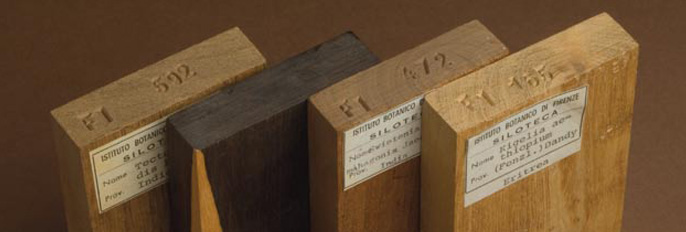Ancillary collections

The collections that complement those of the herbaria are of considerable scientific and historical importance. Monographs are available for each collection from the volume edited by Mauro Raffaelli The Museum of Natural History of the University of Florence: The botanical collections, published by Firenze University Press (essays by Piero Cuccuini, Chiara Nepi and Guido Moggi; English text at the bottom of the pages).
The "Carpotheque"
The term «carpotheque» is generally applied to a part of a plant collection that, because of the size or shape of the specimens or because they are particularly delicate, is preserved in jars or boxes and kept separately from the exsiccata attached to sheets.
With its approximately 14,000 specimens, the Carpotheque of the botanical collections is the largest in Italy, as well as one of the most important in the world both from a scientific and historical point of view.
The Gall Herbarium
The collections of galls or caecids, that is the protuberances produced on plants by bites of mites and insects or by the attack of fungi and bacteria were initiated at the end of the nineteenth century. The collection is divided into two parts: a general one, open to the acquisition of new samples, made up of mostly Tuscan material; the other is the Cecidiotheca Italica which has 575 samples kept in envelopes attached to herbarium sheets.
The ethnographic collection
It includes collections of artifacts and derivatives of plant origin, such as pharmacological preparations, dyes, rugs, ropes, hats, fibers, fans, baskets, paper etc. The origin of the collection dates back to Filippo Parlatore, who took care of adding a collection of products to the actual herbaria that proves itself useful to illustrate the use of plants in the daily life of the peoples of the various parts of the world.
The paleobotanical collection
The fossil remains of plants are a fundamental document to understand the changes that have occurred in the plant world from the Paleozoic era to today.
The collection of plant fossils was started by Filippo Parlatore and grew considerably between 1843 and 1874. Today it includes more than 8 thousand samples also thanks to recent acquisitions (starting from the investigations in the ligniferous deposits of the upper Valdarno basin).
The pollen collection
The collections of pollen grains, preserved in their natural state in test tubes or as microscopic preparations included in resins or other means, are useful comparative tools for paleoecology, archeology and allergology studies. The collection includes 849 identified pollens, plus a few dozen yet to determine.
The seed collection
The seeds are fundamental organs for the plant as they provide for the protection and safeguard of the embryo in view of future germination. They also constitute a good diagnostic element to identify the various plant species.
The Botany Section’s seed collection has a total of 2,800 samples. Worthy of mention are those collected by Father Giuseppe Giraldi, missionary in China between 1888 and 1901.
The Teratological Herbaria
Among its lesser known collections, the Museum also preserves one of teratomata or botanical "monstrosities", that is, made up of plant samples that have deformed, flattened organs, with parts fused or grown in an atypical or exaggerated way. These oddities often present traces of genetic abnormalities or attacks from viruses or other pathogens. The Teratological Herbarium is made up of 45 packets.
The Xylotheque
The Botany Section of the Museum preserves a collection of woods among the largest in Europe, in fact the only one present in Italian university institutions. The initial nucleus of the xylotheque dates back to the early years of the Grand Ducal Museum and was then considerably increased under the direction of Filippo Parlatore. Today there are almost 5,500 samples from all over the world, with numerous series of duplicates, for a total of about 30 thousand finds.
An improved display system has been set up for easier access and greater visibility of the material. The wooden finds are now organized according to the systematic order also used for the samples of dried plants present in the Central Herbarium.
Heads of collections Lorenzo Cecchi | Lorenzo Lastrucci
Last update
07.09.2021
